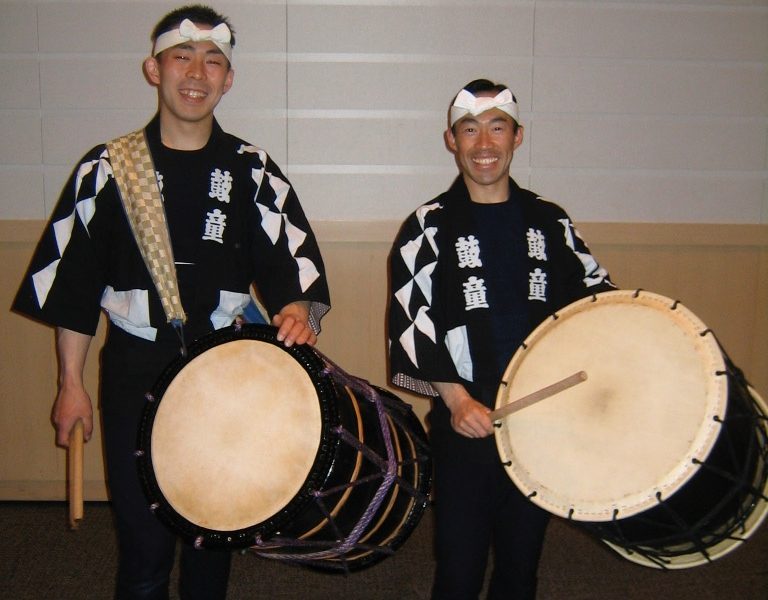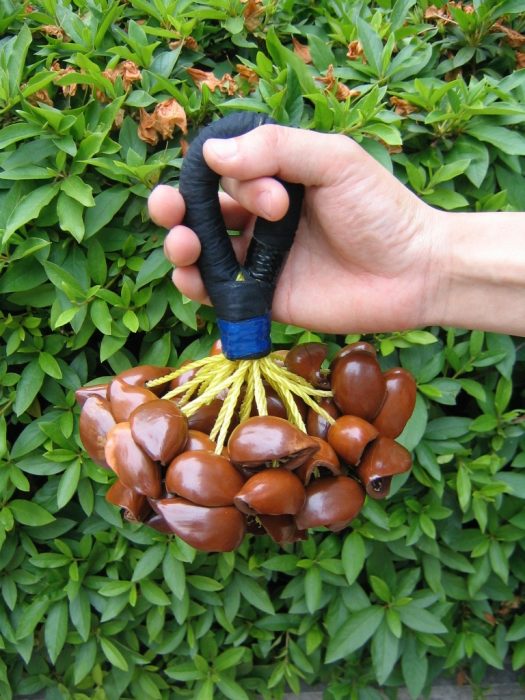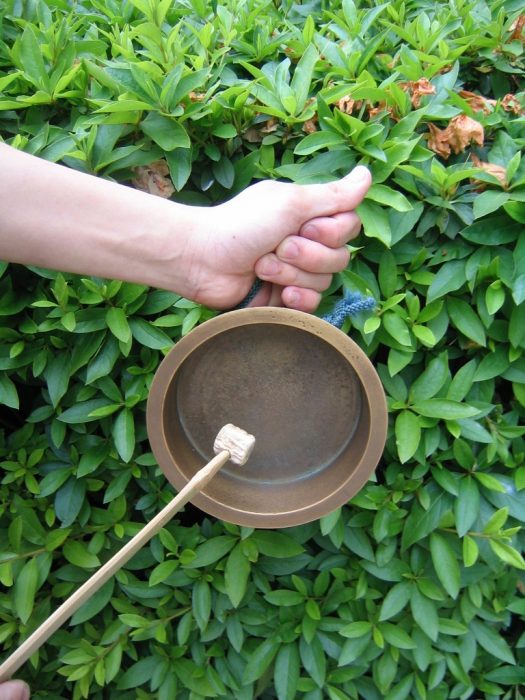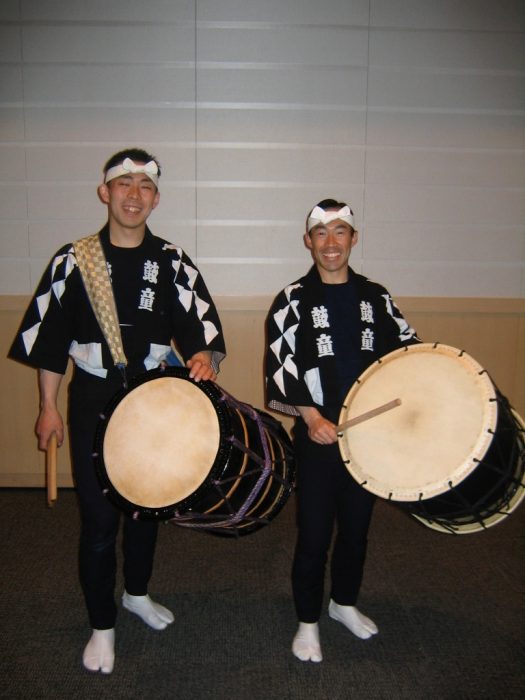
Others: Taiko drummers Kodo
By Judit Kawaguchi
Jun Akimoto, Kodo’s manager told me how revolutionary this arrangement really was. “Before Tomoe, we only played solo with our large drums so Bando Tamasaburo’s idea of creating an energy flow by playing three of our biggest drums simultaneously was a complete surprise and an amazing innovation. We loved his concept and went along with it.” Kodo has always been open to new ideas. Afterall, this is the group that lifted the taiko onto the world stage and has been casting it in the leading role for over 30 years.
Mayusa Oda, the editor of Bachi-Bachi, a magazine dedicated to taiko and tsugaru shamisen, credits Kodo with revolutionizing taiko’s musical history.

“The taiko is the heartbeat of the Japanese people, almost as if it was part of our DNA. We play it at harvest festivals, religious ceremonies but it only became a fixture in the theater thanks to Kodo. When in the 1970’s we first saw them play taiko on stage, we were shocked because we were so used to only seeing it outdoors at festivals but suddenly the taiko was in a theater. We were stunned!”
Hitoshi Mogi, the National Noh Theater’s producer’s reaction was similar. ” Yes, I was surprised, too because the taiko has been a sacred instrument, used in Shinto rituals, in kagura dances, and played the important role of greeting the gods. Also the mikoshi, our portable shrines, are accompanied by drums. Of course, in kabuki, bunraku and at sumo events drums are beaten but the religious connotation is always there. For example, at sumo events the drums not only announce time but also signal welcome and farewell to the gods. In the percussion accompaniment which provides the sound effects in kabuki, taiko is used effectively when a divine spirit appears or something mysterious manifests itself. Rain, thunder, even the sound of snow are expressed by taiko and the taiko represents the spirits of the natural world. “
However, in the early 1970’s, for the members of Sado no Kuni, Ondekoza, as Kodo was called before 1981, the religious aspect of taiko did not seem very important. They saw it more as a means to achieve their bigger goal: to build a school for Japanese performing arts and taiko shows seemed like a feasible way to finance their dream. The plan worked to some extent; their performances were a huge success but their university was never built. Instead, the group was re-launched as Kodo in 1981, moved into Kodo village on Sado island and developed a strategy to introduce taiko to the world. By 1984, they were ready to travel abroad and have been on the road ever since with their wildly successful and ever-changing One Earth Tour.

Tomohiro Mitome, a veteran drummer who has already spent 15 years making Kodo a world class music phenomenon, explained it that way: “All our shows are part of the One Earth Tour because we think everyone shares pretty much the same values. Our desire is to form a musical bond between people through the taiko drum.”
They certainly are doing just that: so far they performed in forty-two countries and toured in most parts of Japan.
Imagine seven shime-daiko, small rope-tuned drums lined up on the stage, with 7 drummers in white headbands, black and white happicoats, in motionless quiet and fierce concentration, sitting behind the drums. The theater is covered in silence and anxious expectation. Somewhere on stage a tiny sound is born, like the scratch of a hungry fork in an empty steel can. It is hard to tell where it comes from as the drummers’ hands are hidden behind their taiko and it seems that none of them had made a move. Yet now something similar to the call of a tiny metronome, lost and looking for its purpose, is heard.
Suddenly an explosion, a high pitched shriek from the center of the stage, like when someone turns up the volume on a stereo from zero to its maximum and back, all in a matter of seconds. This is Monochrome, a long, eerie musical score with an amazing diversity of sound effects. One moment the dora gong is a lovely, gentle, atmospheric device, next it opens to a crescendo as three drummers get up to play the three big miya-daiko. The beats reverbate on everything in the theater; the people, the chairs, the back wall: they all answer back to the players. “The taiko is not an instrument just to hear but to feel with one’s whole body,” says Mitsuru Ishizuka, a fantastic player who found that he could express himself through the taiko more than with anything else.
Hitoshi Mogi says that “the taiko has a metaphysical attraction to the point that it distinguishes it from other musical instruments. Taiko is not heard with ears but the vibrations are felt through the whole body, and their energy is believed to have magical powers.“ Taiko is still played at every festival and ancient texts from the Heian period in the 11th century describe how in the past drums and flutes served as an accompaniment to rice planting.
Daisuke Taniguchi, one of Kodo’s tour managers explained that even today, its members see farming as the basis for their musical activity. “Planting and harvesting movements are crucial for the development of a strong body necessary for taiko drumming. But it is not just the physical power but also the feeling of connection to nature and appreciation of life that we learn by working out in the fields a couple of times a week.”
Kodo is based on Sado island in Niigata prefecture and includes 23 performers, 25 staff members and 20 apprentices. The students, 15 men and 5 women, all live together in an old school building and discipline and order rule their lives.
Taniguchi: “We all get up at 4:50, clean the whole building together, then from about 5:25 we run 10 kilometers, rain or shine. We take turns cooking, with three people in charge of making the three meals for the day. From 6:50 till 7:30 we have breakfast, which is usually natto, grilled fish, rice, miso soup, yogurt with fruits.
Then from 7:30 to 8:30 we stretch in a big exercise hall: we each have our own stretching regimen in order to prevent injuries. Then it’s time for our morning practice which varies each day. The curriculum includes noh, kyogen, drums, dance, songs, farming. Some of the players teach the apprentices. Then the three cooks for the day make lunch from 11:30 and at 12:30 we all eat again. We learn to be efficient and self-sufficient. We also learn teamwork, essential for our stage work. Afternoons and evenings are for more practice, then by evening, we are beat and ready to fall into our futons.”

The demanding workload is crucial because Kodo accepts apprentices based more on their honest desire to play and their willingness for the tough work than their previous taiko experience. Gen Matsui, another tour manager told me about their two-year apprentice system. “We ask for an essay because we would like to know what the person’s motivation is and why they would like to be part of our group. Then we have an interview and it really depends on the applicants what they do. They might dance or play drums. Being a good drummer already is not a prerequisite to get into Kodo but it is to get on stage so for some it takes many years to make it to the stage. But they hang on and practice hard because they love taiko.”
Hitoshi Mogi thinks Japanese people’s relationship with taiko is very deep. “For the Japanese, trees are sacred, as they are antennas and resting places for the spirit of gods. Therefore taiko is a significant means of communication with the gods, basically with nature. Seeing these precious trees made into an instrument really hits home the idea that taiko drums are the connection or maybe even the forms of gods.“ For Tomohiro Mitome, playing is very special. “I feel respect for the taiko and even if I don’t bow in front of it, I still know in my heart how much it means to me.”
Mitsuru Ishizuka added: “Whether I feel sad or happy, it doesn’t matter. Once I am beating the taiko, everything falls into its right place and I feel connected to everyone in the audience. This why we travel around the globe: to connect everyone, one beat at a time.”
For further information, please check Kodo’s website at http://www.kodo.or.jp/
The National Theater’s website is connected to the Japan Arts Council site at http://www.ntj.jac.go.jp
Bachi-Bachi can be accessed at http://hogaku.com
A version of these interviews appeared in JSELECT magazine in August 2005
This QuoteThe taiko is the heartbeat of the Japanese people. — Kodo